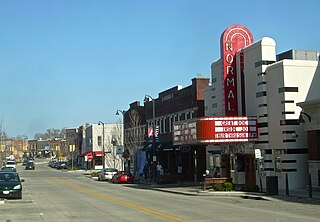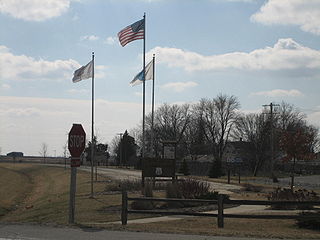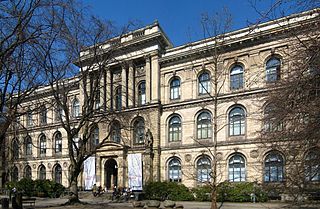
Galena is the largest city in and the county seat of Jo Daviess County, Illinois, United States. It had a population of 3,308 at the 2020 census. A 581-acre (235 ha) section of the city is listed on the National Register of Historic Places as the Galena Historic District. The city is named for the mineral galena, which was in the ore that formed the basis for the region's early lead mining economy.

Bloomington is a city in and the county seat of McLean County, Illinois, United States. The 2020 census showed the city had a population of 78,680, making it the 13th-most populous city in Illinois and the fifth-most populous outside the Chicago metropolitan area. It is adjacent to the town of Normal, and is the more populous of the two principal municipalities of the Bloomington–Normal metropolitan area, which has a population of roughly 170,000. Bloomington is 135 miles (217 km) southwest of Chicago and 162 miles (261 km) northeast of St. Louis. Bloomington is home to Illinois Wesleyan University and the headquarters for State Farm and Country Financial. Bloomington is also home to the minor league hockey team Bloomington Bison.

Carlock is a village in McLean County, Illinois, United States. The population was 548 at the 2020 census. It is part of the Bloomington–Normal Metropolitan Statistical Area.

Colfax is a village in McLean County, Illinois, United States. The population was 996 at the 2020 census. It is part of the Bloomington–Normal Metropolitan Statistical Area.

Normal is a town in McLean County, Illinois, United States. As of the 2020 census, the town's population was 52,736. Normal is the smaller of two principal cities of the Bloomington–Normal metropolitan area, and is Illinois' seventh most populous community outside the Chicago metropolitan area. The main campus of Illinois' oldest public university, Illinois State University, a fully accredited four-year institution, is in Normal, as is Heartland Community College, a fully accredited two-year institution. Chris Koos has been the mayor of Normal since 2003.

Towanda is a village in McLean County, Illinois, United States. The population was 431 at the 2020 census. It is part of the Bloomington–Normal Metropolitan Statistical Area.

Illinois State University (ISU) is a public research university in Normal, Illinois, United States. It was founded in 1857 as Illinois State Normal University and is the oldest public university in Illinois. The university emphasizes teaching and is recognized as one of the top ten largest producers of teachers in the US according to the American Association of Colleges of Teacher Education. It is classified among "R2: Doctoral Universities – High research activity".

John Wesley Powell was an American geologist, U.S. Army soldier, explorer of the American West, professor at Illinois Wesleyan University, and director of major scientific and cultural institutions. He is famous for his 1869 geographic expedition, a three-month river trip down the Green and Colorado rivers, including the first official U.S. government-sponsored passage through the Grand Canyon.

Illinois Wesleyan University is a private liberal arts college in Bloomington, Illinois. Founded in 1850, the central portion of the present campus was acquired in 1854 with the first building erected in 1856.

Angel Mounds State Historic Site, an expression of the Mississippian culture, is an archaeological site managed by the Indiana State Museum and Historic Sites that includes more than 600 acres of land about 8 miles (13 km) southeast of present-day Evansville, in Vanderburgh and Warrick counties in Indiana. The large residential and agricultural community was constructed and inhabited from AD 1100 to AD 1450, and served as the political, cultural, and economic center of the Angel chiefdom. It extended within 120 miles (190 km) of the Ohio River valley to the Green River in present-day Kentucky. The town had as many as 1,000 inhabitants inside the walls at its peak, and included a complex of thirteen earthen mounds, hundreds of home sites, a palisade (stockade), and other structures.

The Natural History Museum is a natural history museum located in Berlin, Germany. It exhibits a vast range of specimens from various segments of natural history and in such domain it is one of three major museums in Germany alongside Naturmuseum Senckenberg in Frankfurt and Museum Koenig in Bonn.

The McLean County Courthouse and Square is located in downtown Bloomington, Illinois. The site is on the National Register of Historic Places and encompasses the old McLean County Courthouse and the courthouse-facing sides of three downtown blocks. All 4 floors of the building are now occupied by the McLean County Museum of History for exhibits, collections storage, and offices. The historic buildings at the other side of the square were destroyed by fire in the 1980s. The Square is bordered by four Bloomington streets: Main Street, Center Street, Jefferson Street and Washington Street. The site was home to three previous courthouses before the current one was completed in 1903. The first courthouse at the site was built in 1831, and the second in 1836. The third was built in 1868, but suffered major damage from fire on June 19, 1900.

Stephen Alfred Forbes was the first chief of the Illinois Natural History Survey, a founder of aquatic ecosystem science and a dominant figure in the rise of American ecology. His publications are striking for their merger of extensive field observations with conceptual insights. Forbes believed that ecological knowledge was fundamental for human well being. Forbes was important to the development of ecological theory. He was acknowledged by the National Academy of Sciences as "the founder of the science of ecology in the United States".

Benjamin Franklin Mudge was an American lawyer, geologist and teacher. Briefly the mayor of Lynn, Massachusetts, he later moved to Kansas where he was appointed the first State Geologist. He led the first geological survey of the state in 1864, and published the first book on the geology of Kansas. He lectured extensively, and was department chair at the Kansas State Agricultural College.

The Minnesota History Center is a museum and library that serves as the headquarters of the Minnesota Historical Society. It is near downtown Saint Paul, Minnesota.

Broadview Mansion, is a twenty-two room Edwardian style mansion located in Normal, Illinois, near Illinois Wesleyan University. The three-story estate, originally situated on five acres of land, was built in 1906 for Bird Calladay and Margaret VanLeer. The mansion was formerly known as the VanLeer mansion. It is currently owned and operated by the Immanuel Bible Foundation.
William Trabue Major (1790–1867) was a prominent religious leader in Bloomington, Illinois in the mid-19th century. He founded the First Christian Church and built the city's first public meeting hall, Major's Hall, which hosted an early convention of the Illinois branch of the Republican Party and became best known as the site of "Lincoln's Lost Speech".

Almon Harris Thompson, also known as A. H. Thompson, was an American topographer, geologist, explorer, educator and Civil War veteran. Often called "The Professor" or simply "Prof", Thompson is perhaps best known for being second in command of John Wesley Powell's Second Geographical Expedition (1871–1875), a federally funded scientific expedition that retraced the route of Powell's original expedition in order to further explore and map the drainages and canyons of the Green and Colorado Rivers in what is now southern Utah and northern Arizona. Thompson's diary of the expedition was originally published in the Utah Historical Quarterly in 1939. Through his work on the Powell expeditions and later as a geographer at the U.S. Geological Survey, he was responsible for naming many geographic locations in the Western United States. Thompson is also known for being a founding member of the National Geographic Society.
Sarah Woodruff Walker Davis was born in Lenox, Massachusetts to William Perrin Walker and Lucy Adam Walker. She was a fairly educated woman for her time, attending Hartford Female Seminary in Connecticut, where she studied under the tutelage of Catharine Beecher and Harriet Beecher Stowe. While she dropped out of school and returned to her hometown, Sarah remained an intellectual woman for her entire life. Back in Lenox, Sarah met David Davis, a young lawyer who was practicing in Bloomington, Illinois. They married in 1838 and had a long and loving marriage, evidenced by the many letters they sent each other while Judge Davis was working in Washington, DC and Sarah was at home in Bloomington. They built their dream home, Clover Lawn, now known as the David Davis Mansion, in Bloomington from 1870–1872. Two of their children, George and Sallie, lived to adulthood.
Joseph Gillespie was an American politician from New York. Moving with his family to Illinois at a young age, Gillespie fought in the Black Hawk War before studying law at Transylvania University. Upon graduation, he was elected to a two-year term in the Illinois House of Representatives, where he once jumped out of a window with Abraham Lincoln to stop a quorum. He was elected to the Illinois Senate in 1846, serving for twelve years. He was a founder of the Illinois Republican Party and served on the Illinois circuit courts for twelve years.
















